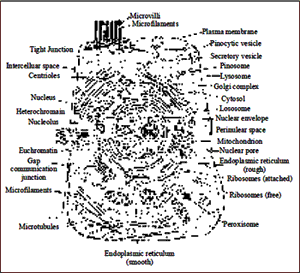(HOT) UPSC Current Affairs 2025 PDF
NEW! The Gist (NOV-2025) | E-BOOKS
(IGP) IAS Pre: GS - Science & Technology : Biology - Cell
Biology
CELL
WHAT IS CELL?
All living organisms on earth are divided in pieces called cells. Cells are small compart-ments that hold all of the biological equipments necessary to keep organisms. Cells carry out all the basic functions of life: growth, metabolism and r e pr o- duct ion . There are someorganisms like amoeba consists of a single cell. This single cell increasein size and when it attains a certain size, it divides into two separates individuals. In case of multi cellular organisms, the cell also divides into two parts, but the two parts remaining joined this process is repeated crore of times so that body mass is built up. In this process some cells become specialized to perform specific functions but other retains their capacity for cell division throughout life.

WHO GAVE THE CELL THEORY?
The term cell was coined by Robert Hooke in 1665. In 1838 matthias schleiden, German botanist proposed the idea that all plants consists of cells. In 1839, The Eodor Schwann a German zoologist asserted that all plant and animals are made up of cells. This finding forms the basis of cell theory.
COMPONENTS OF CELL?
In the living organisms there are two types of cellular organizations. If we look at very simple organisms like bacteria and blue-green algae, We will discover cells that have no defined nucleus, these are prokaryotes cells. The cells which have definite nucleus are known as eukaryote. But the things which both have in common is that there are compartments surrounded by some type of membranes. These are called cell membranes.
Cell membranes : It is like a plastic bag with some tiny holes that bag holds all of the cell pieces and fluids inside the cell and keeps foreign particles outside the cell. The holes are there to let some things move in and out of the cell. Compounds called proteins and phospholipids make up most of the cell membrance.the phospholipids make the basic bag. The proteins are found around the holes and help move molecules in and out of the cell. Substances like Co2 and O2 can move across the cell membranes by a process called diffusion. Diffusion is a process of movements of substance from a region of high concentration to a region where its concentration is low. Water also obeys the law of diffusion. The movement of water molecules is called osmosis.
Cytoplasm : It is the fluid that fills a cell. Scientists used to call the fluid proto plasm.cytoplasm contain many specialized cell called organ cells. Each of these organ cells performs a specific function for the cell. Cell organells : Organells are living part of the cell have definite shape, structure and functions. To keep their function different from each other these organelles use membranes bound little structure with in them selves. Some of the important organells are :
(a) Endoplasmic reticulum : It is a network of tulsular membranes connected at one end to the nucleus and on the other to the plasma membranes. Endoplasmic reticular (ER) are two types:-rough endoplasmic reticular (RER) and Smooth endoplasmic reticulum (SER).
Functions of ER:
- It forms the supporting skeleton frame work of the cell.
- It provides a pathway for distribution of nuclear material.
- It provides surface for various enzymatic reactions.
(b) Ribosomes : it synthesis protein, and ER sent these protein in various part of the cell. Where as SER helps in the manufacture of fats. Functions of these proteins and fats :
- Protein and fat (lipid) help in building the cell membranes. This process is known as membranes biogenesis.
- Some other protein and fat functions as enzymes and hormones.
- SER plays a crucial role in detoxifying many poisons and drugs.
(c) Golgi apparatus : it is found in most cell. It is another packaging organelle like the endoplasmic reticulum. It gathers simple molecules and combines them to make molecules that are more complex. It then takes those big molecules, packages them in vesicles and either stores them for faster use or sends them out of the cell. Other functions:
- Its functions include the storage modifications and packaging of products in vesicles.
- It is also the organ Elle that builds lysosomes (cells digestion machines).
(d) Lysosomes: It is a kind of waste disposal system of the cell. It helps to keep the cell clean by digesting any foreign material. Old organs cell end up in the lysosomes. When the cell gets damaged, lysosomes may burst and the enzymes digest their own cell. Therefore lysosomes are also known as the “suicide ways” of the cell.
(e) Mitochondria: It is known as the power house of the cell. The energy required for various chemical activities headed for life is released by mitochondria in the form of ATP (adenosine-triphosphate) molecules.
- ATP is known as the energy currency of the cell. The body uses energy are stored in ATP for making new chemical compounds and for mechanical work.
- Mitochondria are strange organells in the sense that they have their own DNA and ribosomes, there fore mitochondria are able to make their own protein.
- Mitochondria is absent in bacteria and the red blood cells of mammals and higher animals.
(f) Centrioles: It is a micro-tubular structure; centrioles are concerned with cell division. It initiates cell division.
(g) Plastids: These are present only in plant cells. There are two types of plastids:-chromoplastes (colour plastides) and leucoplast (white or colourless plastids).
- Chromoplast impart colour to flowers and fruits.


